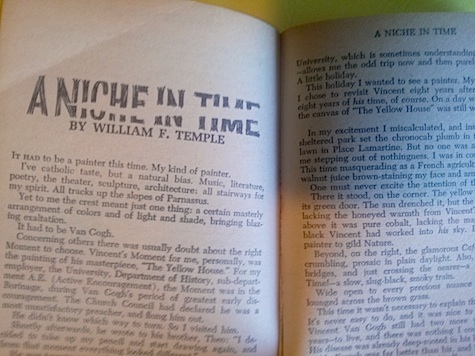Some days, before boarding the subway, I like to grab an old book from my shelf that I’ve never read, and randomly open it to any odd page. Last week, it was a dog-eared Ace paperback called World’s Best Science Fiction 1965, which contained a bunch of great science fiction stories published in the previous year. The story I opened to was called “A Niche in Time” by William F. Temple. As I began reading, I gasped. Was a time traveler visiting Vincent Van Gogh and was it reminding me very much of the 2010 Doctor Who episode “Vincent and the Doctor?” In the words of the tenth Doctor…OH YES!
Now, any hardcore Who fan knows “Vincent & the Doctor” was written by screenwriter Richard Curtis, probably more famous the world over for penning such epic romantic comedies like Four Weddings and a Funeral, Love Actually, and more. I am a fan of these films. They are watchable and truly decent pieces of work, even if they are saccharine and over-the-top, and occasionally starring Hugh Grant. In my estimation you have to be kind of evil to not like at least one aspect of one of his films.
“Vincent and the Doctor” always stood as an out-of-place episode for me, however. I know everyone loved it, and while upon subsequent viewings I liked it better, it still always felt off to me. Like various premises were competing for attention, and the ramifications of the Doctor showing Vincent the future felt reckless and a bit too corny—even by the standards of the saccharine Curtis and the melodramatic Who. Still, it’s a memorable episode and a great concept. I don’t think Richard Curtis ripped off this William F. Temple story, but…I wonder if there was a subconscious influence.
The story involves a man named Jon Everard, and he is a Visitor. He pops into his chrono-cab and visits geniuses and basically tells them they are going to be great. He then erases their memory, but contends the positive influence still lingers in the subconscious, and that the viewing of success in the future is related to the creation of the work in the past. Time isn’t straightforward, so essentially, an artist or other brilliant person can be inspired by themselves, even if they don’t really remember it consciously. It’s a lovely story, and sort of sad. Just like “Vincent and the Doctor.”

So, Everard visits Van Gogh in the early pages of the story. Van Gogh is living in the same house, during the same period in which the Doctor and Amy visited him in their story. And just like the Doctor and Amy, Jon Everard takes Van Gogh into the future to see his work being exhibited. From the story:
London in midwinter, 1948. A dark gray day by the dark gray Thames. There was an endless drizzle from a sky of mud. We arrived behind a telephone booth—its red was the only visible splash of color—on a side street.
I led him around the corner, and there on the sidewalk, patient in the rain, was a line of more than a thousand people. Slowly, they were shuffling into the Tate Gallery. And as the big buildings swallowed the head of the line, so other joined, the tail, keeping the line at a constant length.
“That,” I told him, “has been going on all day. It went on yesterday. So it will go on, day after day. A thousand people an hour, every hour. All records for attendance at an art exhibition have already been smashed. These people, weary after a long war, are starved of sunshine and color. They flock here to feast their souls on the work of one great artist.”
“Rembrandt?” he guessed, incorrectly, watching the traffic on the street with a wondering but wary eye. It was thin today, but I had warned him of it.
“No. You—Vincent Van Gogh.”
Now, the shape of the story sees Jon Everard visiting other historical geniuses, but this scene is notable for a lot of reasons. Just as in the Who episode, at Van Gogh’s most depraved (several references are made to his mental illness) the artist is whisked into the future to see a grandiose art exhibition of his work. And if that similarity wasn’t eerie enough. There’s also the part when Van Gogh waxes about what he thinks about life. Remember when he gives the Doctor and Amy that speech about how he sees the world? Well check this out:
“My mind is purely that of an artist. It feels its way through a kind of colored fog. It reasons poorly, sees nothing sharp and clear in black and white. Mathematics has always baffled it. It can’t grasp scientific technicalities. It merely apprehends form, tone, shades…”
To be fair, the various Van Gogh speeches in “Vincent and the Doctor” are written little better and snappier than this, but the tone is similar. “A Niche in Time” was published in Analog in 1964, and is also included in most of Temple’s best-of collections. Plus, he’s British. Could Richard Curtis have read this story at a young age and been influenced by it? Even without knowing it?
Or maybe, what’s more likely is this: either Jon Everard, or the Doctor, took a young Richard Curtis to the future in order to watch Love Actually. Now there’s a story I want to see…or read!
Ryan Britt is a former staff writer for Tor.com. His work has been published with The New York Times, Nerve, Omni Reboot, Clarkesworld, and elsewhere. He rips off himself all the time.










